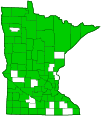American common reed
(Phragmites australis ssp. americanus)
Conservation • Wetland • Description • Habitat • Ecology • Use • Distribution • Taxonomy
Description |
||
American common reed is a perennial, reed-like grass that rises on a single stem from an underground stem (rhizome) and fibrous roots. It slowly forms large colonies that are not dense enough to crowd out all other species. The rhizome is stout, almost perfectly round in cross section, and usually under ⅝″ in diameter. The stem (culm) is annual, stout, hollow between the nodes, and unbranched. It is 3 ⁄16″ to ⅝″ in diameter and usually 4′ to 6½′ in height, but may be 8½′ tall or taller. It is flexible, leafy, and hairless, shiny, smooth, and light green to maroon, sometimes maroon only at the nodes. It is sometimes covered with a whitish, waxy film (glaucous). There are often small black spots between the nodes caused by a native fungus. In the spring and summer the lower part of the culm, when the leaf is removed, is reddish to chestnut brown. In the winter it is light chestnut brown to light brownish-gray. The leaves are alternate, ascending to arching, yellowish-green, and deciduous, falling away in the winter and exposing the culm. The blades are linear lance-shaped, flat, flexible, 6″ to 24″ long, and ¾″ to 1½″ wide. They taper to a slender, thread-like point at the tip. The upper and lower surfaces are hairless. The upper surface has numerous parallel veins. The midvein is noticeably thickened on the underside. The lower part of the leaf that surrounds the stem (sheath) is usually hairless, sometimes hairy along the margins. The margins of the sheath overlap. Where the leaf blade meets the sheath there is a thin, pliable appendage (ligule). The ligule is 1.0 to 1.7 mm long and has a fringe of white hairs. In the winter any sheaths remaining on the culm pull away easily. The inflorescence is a large, dense, plume-like cluster (panicle) of numerous ascending to drooping branches. The panicle is egg-shaped to lance-shaped in outline, 6″ to 14″ long, and 3″ to 8″ wide. It is silky and purplish or reddish when in bloom, light tan to dark brown when in fruit. Each spikelet is egg-shaped to inversely triangular on outline, somewhat flattened, and ⅜″ to ⅝″ long. One spikelet consists of an upper and lower protective bract (glume) and 3 to 8 florets. The lower 1 or 2 florets are male (staminate), the upper 1 or 2 are reduced in size and nonfunctional (sterile), and the remaining ones contain both male and female parts (bisexual). The florets are closely spaced along a zigzagged central axis (rachilla). The rachilla is densely covered with silky, ¼″ to ⅜″ long hairs. The glumes have 1 to 3 veins, are hairless, and are shorter than the florets. The lower glume is ⅛″ to ¼″ long. The upper glume is much longer, 3 ⁄16″ to 7 ⁄16″ long. Each fertile floret consists of an outer protective bract (lemma), an inner protective bract (palea), and reproductive parts. The lemma is 5 ⁄16″ to ½″ (8 to 13.5 mm) long, is rounded on the back, and has 3 veins. The palea has 2 veins. Bisexual florets have 3 stamens with purplish anthers. Staminate florets may have fewer stamens. Fruits are seldom produced and when they are they rarely mature. A mature fruit (caryopsis) is 1 ⁄16″ to ⅛″ long, oblong, and circular or slightly flattened in cross section, with a short beak at the tip. |
||
Height |
||
4′ to 16′ |
||
Similar Species |
||
| European common reed (Phragmites australis ssp. americanus) is often found in high densities that exclude all other plants. The leaves are darker in color, often bluish-green. In winter the leaves remain on the culm and do not pull away easily. Culms in the growing season are slightly ridged and dull, not shiny. The inflorescence is more dense and persists throughout the winter. Two other differentiating characteristics, a shorter ligule and a shorter glume, are microscopic and can not be measured in the field. | ||
Habitat |
||
Wet and muddy areas. Marshes, sloughs, lake shores, and alongside streams. |
||
Ecology |
||
Flowering |
||
July to August |
||
Pests and Diseases |
||
|
||
Use |
||
|
||
Distribution |
||||
|
Sources |
|||
| 3/19/2023 | ||||
Nativity |
||||
Native |
||||
Occurrence |
||||
Very common and widespread in Minnesota |
||||
Taxonomy |
|||
| Kingdom | Plantae (Plants) | ||
| Subkingdom | Pteridobiotina | ||
| Phylum | Tracheophyta (Vascular Plants) | ||
| Class | Liliopsida (Monocots) | ||
Order |
Poales (grasses, sedges, cattails, and allies) | ||
Family |
Poaceae (grasses) | ||
| No Rank | PACMAD clade | ||
| Subfamily | Arundinoideae (reeds, giant canes, and allies) | ||
| Tribe | Molinieae | ||
| Subtribe | Moliniinae | ||
Genus |
Phragmites (common reeds) | ||
| Species | Phragmites australis (common reed) | ||
Subordinate Taxa |
|||
|
|||
Synonyms |
|||
|
|||
Common Names |
|||
American common reed American reed common reed common reed grass giant reed native common reed North American common reed |
|||
Glossary
Caryopsis
The dry, one-seeded, achene-like fruit of a grass, formed from a single carpel, not opening at maturity, and with the fruit wall (pericarp) fused to the seed coat.
Culm
The hollow or pithy stem of a grass, sedge, or rush.
Glaucous
Pale green or bluish gray due to a whitish, powdery or waxy film, as on a plum or a grape.
Glume
A chaffy, empty, sterile bract at the base of a grass spikelet. Glumes usually occur in pairs, but occasionally only one is present.
Lemma
The outer, lowermost of the pair of bracts at the base of the grass floret; it ensheathes the palea.
Ligule
In grasses, a membranous appendage at the junction of the leaf and the leaf sheath, sometimes no more than a fringe of hairs. In flowering plants, the flat, strap-shaped, petal-like portion of the corolla of a ray floret.
Linear
Long, straight, and narrow, with more or less parallel sides, like a blade of grass.
Node
The small swelling of the stem from which one or more leaves, branches, or buds originate.
Palea
The inner, uppermost of the pair of bracts at the base of the grass floret.
Panicle
A pyramidal inflorescence with a main stem and branches. Flowers on the lower, longer branches mature earlier than those on the shorter, upper ones.
Rhizome
A horizontal, usually underground stem. It serves as a reproductive structure, producing roots below and shoots above at the nodes.
Sheath
The lower part of the leaf that surrounds the stem.
Spikelet
The basic unit of inflorescence in grasses, composed of usually two glumes and one or more florets.
Visitor Photos |
|||||
Share your photo of this plant. |
|||||
| This button not working for you? Simply email us at info@MinnesotaSeasons.com. Attach one or more photos and, if you like, a caption. |
|||||
|
|||||
MinnesotaSeasons.com Photos |
|||||
Plant |
|||||
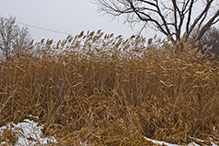 |
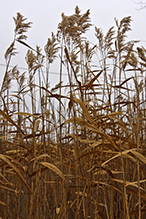 |
||||
Culm |
|||||
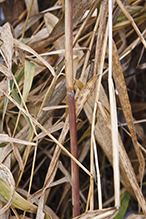 |
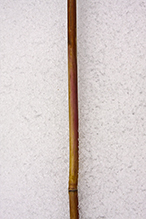 |
||||
Infructescence |
|||||
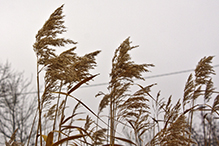 |
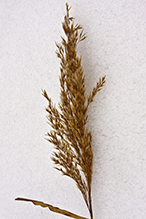 |
||||

Slideshows |
||

Visitor Videos |
|||
Share your video of this plant. |
|||
| This button not working for you? Simply email us at info@MinnesotaSeasons.com. Attach a video, a YouTube link, or a cloud storage link. |
|||
Other Videos |
|||

Visitor Sightings |
|||||
Report a sighting of this plant. |
|||||
| This button not working for you? Simply email us at info@MinnesotaSeasons.com. Be sure to include a location. |
|||||
|
|||||
MinnesotaSeasons.com Sightings |
|||||

|
Created: Last Updated: © MinnesotaSeasons.com. All rights reserved. |
